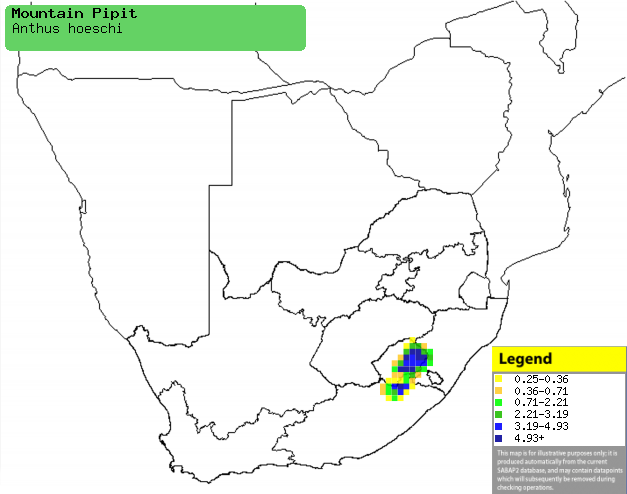|
Anthus hoeschi (Mountain pipit)
Bergkoester [Afrikaans]; Bergpieper [Dutch]; Pipit alticole
[French]; Hochlandpieper [German]; Petinha-das-montanhas [Portuguese]
Life
> Eukaryotes >
Opisthokonta
> Metazoa (animals) >
Bilateria >
Deuterostomia > Chordata >
Craniata > Vertebrata (vertebrates) > Gnathostomata (jawed
vertebrates) > Teleostomi (teleost fish) > Osteichthyes (bony fish) > Class:
Sarcopterygii (lobe-finned
fish) > Stegocephalia (terrestrial
vertebrates) > Tetrapoda
(four-legged vertebrates) > Reptiliomorpha > Amniota >
Reptilia (reptiles) >
Romeriida > Diapsida > Archosauromorpha > Archosauria >
Dinosauria
(dinosaurs) > Saurischia > Theropoda (bipedal predatory dinosaurs) >
Coelurosauria > Maniraptora > Aves
(birds) > Order: Passeriformes
> Family: Motacillidae > Genus: Anthus
Distribution and habitat
In the non-breeding season it is thought to stay in the
area from eastern Angola to north-eastern Angola and southern DRC, but it breeds
in the alpine grassland and heathland of Lesotho and adjacent KwaZulu-Natal and
Eastern Cape.
|
 |
|
Distribution of Mountain pipit in southern Africa,
based on statistical smoothing of the records from first SA Bird Atlas
Project (©
Animal Demography unit, University of
Cape Town; smoothing by Birgit Erni and Francesca Little). Colours range
from dark blue (most common) through to yellow (least common).
See here for the latest distribution
from the SABAP2. |
Movements and migrations
Although not well-known, it is though to be an
intra-African breeding migrant, arriving in its southern African
breeding ground from late October and mainly departing from
March-April.
Food
Its diet is unknown, however it does most of its foraging
on the ground, sometimes in flat grassland or ploughed fields alongside
African pipits.
Breeding
- The nest is probably built by the female, consisting of an open cup made
of coarse grass lined with finer grass stems and rootlets. It is typically
placed in a sloping hollow at the base of a grass tuft, which sometimes
partially conceals it.
- It lays 2-3 eggs, usually in the months from late November to early
January.
Threats
Not threatened.
References
-
Hockey PAR, Dean WRJ and Ryan PG 2005. Roberts
- Birds of southern Africa, VIIth ed. The Trustees of the John Voelcker
Bird Book Fund, Cape Town.
|
